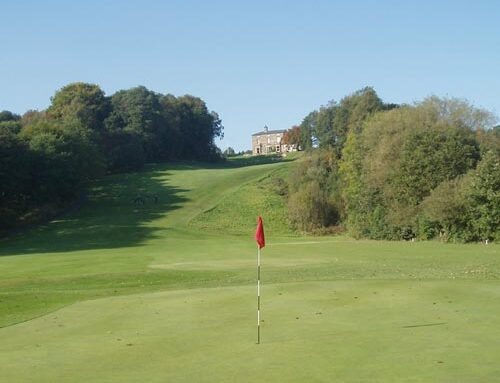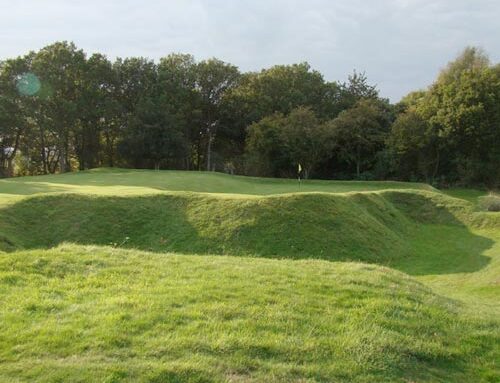The Addington Golf Club
Surrey, England
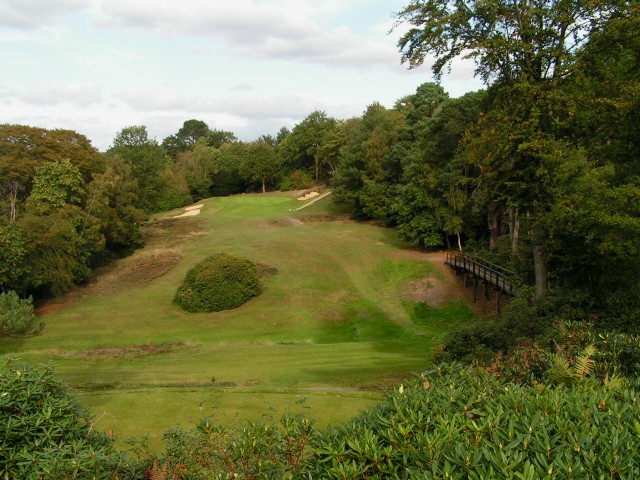
From the sixth through the seventeenth, The Addington is as wild a ride as any inland course in the world. Pictured above is the 230 yard one shot thirteenth played across a fifty foot deep valley.
What do National Golf Links of America, Royal County Down and Royal Melbourne West have in common? How about Merion,Pacific Dunes and The Old Course at St. Andrews? Or Sand Hills, Pine Valley and Royal St. George’s? Oakmont, Friar’s Head and Riviera? They are all great golf courses, the designs of which share several similar tenets. However, beyond that, the courses couldn’t be more different from one another or from the group or for that matter from any other course in the world. This sense of uniqueness, of being one of a kind may indeed be thesingle key attribute that world class courses possess that very good courses do not. And one of the most unique of all golf courses is found just ten miles south of London in Croydon. What makes The Addington unique? Ultimately, of course, it is the course’s collection of golf holes. More in general though, the property itself is truly one-of-a-kind. Originally gravel hills, the rugged property features several ravines throughout and though it has become wooded in nature over time, the property to this day resists being classified as heathland or moorland or parkland or links -it’s simple is what it is. The man who picked the property was the founder of the Club and its architect as well, John Frederick Abercromby. In picking this site, Abercromby left no doubt that his intent from the start was to build a challenging course. The second reason that the course reminds the golfer of none other is that Abercromby himself designed only a few other courses. Just as the singular visions of the driving forces of Pine Valley, Oakmont, and Royal St. George’s help make those courses feel unique, the same can be said of The Addington. The course that was considered Abercromby’s second best – The New Course at The Addington which was across the street from this one – no longer exists. Only Knole Park, Coombe Hill and his first design at Worplesdon give the golf architecture student much insight into Abercromby. With big name modern architects building well more than 100 courses, the golfer eventually feels like he has seen the work before – and in fact he has. Repetition does not creep into the work of the less prolific architect firms like Flynn & Toomey, Thomas & Belland Coore & Crenshaw, who never had any desire to build more than 50 courses.
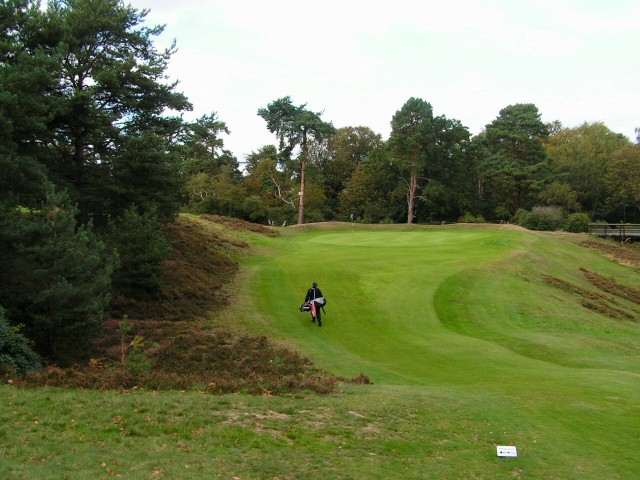
As seen from left to right, woods, heather, topography, great green sites, ravines, bridges – The Addington has it all.
As at Pine Valley Golf Club, the great Harry Colt was a consultant but unlike at Pine Valley, the founder of The Addington stayed alive and Abercromby ran the club and course as a benevolent dictator for more than twenty years after it opened. Continually tinkering with it, there is no doubt that the lion’s share of design credit belongs to Abercromby. Though not much is known of him, he was the first man to coin the phrase, ‘I am the suggestion book!’ According to Henry Longhurst, Aberwas often found at The Addington wearing a green velour porkpie hat and carrying an ancient wooden putter. The most ready conclusion that one can draw from his work is that he thrived on building hazards that were natural in appearance. Though Willie Park had started doing the same several years prior, many architects in the United Kingdom were still building simplistic,geometric designs when Abercromby first built Worplesdon in 1908 and Coombe Hill in 1909. The Addington’s design in 1912 left no doubt that Abercromby was ‘one of the outstanding architects in all of golf’ according to Longhurst. Though he later joined the design firm of Fowler and Simpson after World War I, Abercromby’s greatest achievement was The Addington, as we see below. Holesto Note 1st hole,165 yards; The only criticism of the uphill one shot opener is that it does not make one wish to play golf. Ala the 1st at Royal Lytham & St. Annes, it is a solid, tough hole but is the only hole on the course that is likely not to resonant with the golfer. Nonetheless, it sets the golfer up for a superlative run of seventeen holes.
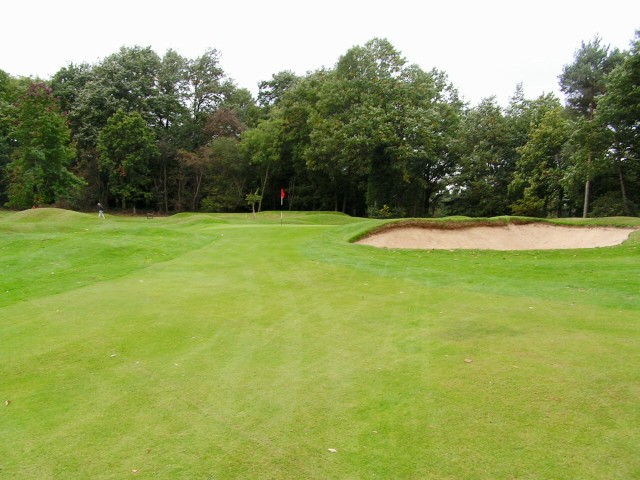
The uphill opener requires a well struck mid iron shot to find the putting surface.
2nd hole, 565 yards; An unbelievably long three shotter for a course that was built in 1912, the key is carrying the crest of the hill that is 410 yards from the tee with one’s second shot. If the drive has gone awry, then carrying the broken ground around the crest of the hill becomes problematic and the third shot might well be blind. Another point to consider is that the fairway beyond the crest slopes right to left, making for a difficult target after a bail-out tee shot down the right away from the trees and bunker.
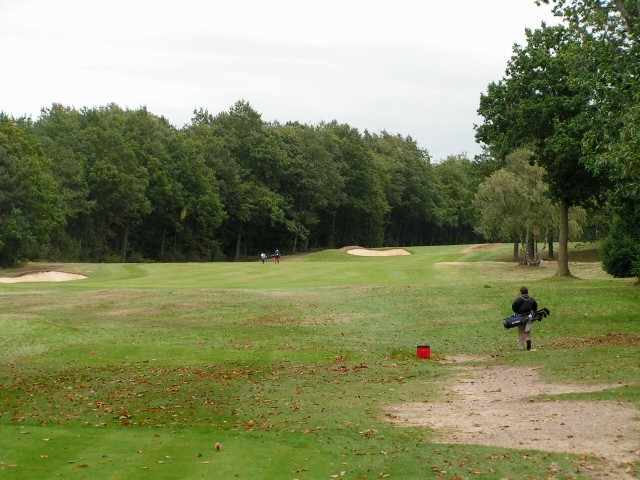
The terrain at The Addington is such that only three holes required fairway bunkers: here, the ninth and eighteenth.The bunker at the crest of the far hill is 410 yards from the tee and two good shots from the golfer will see him past it.
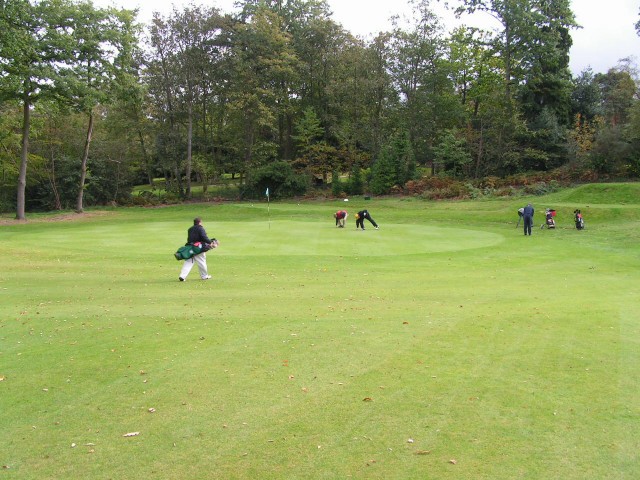
Once over the crest, the golfer is greeted by a bunkerless green that follows the general pitch of the surrounds, which is to say it slopes from high right to lower left. A wonderful green site, in part because it is different from any other on the course.
3rd hole, 210 yards; In addition to being a great admirer of the 13th, Henry Longhurst was a fan of this tough one shotter as well. Abercromby moved only enough dirt to build up the 3rd green and bench it into the hillside. As with the 1st hole, Abercromby had no compunction about using a one shotter to get the golfer to higher ground. Though a fade fits the eye as the green is bunkered right, one member suggests that a draw is the best shot as it leaves the easiest recovery (i.e. anywhere left of the green). A tee ball from a missed fade is often kicked ten to twenty yards away from the green by the sloping left to right terrain.
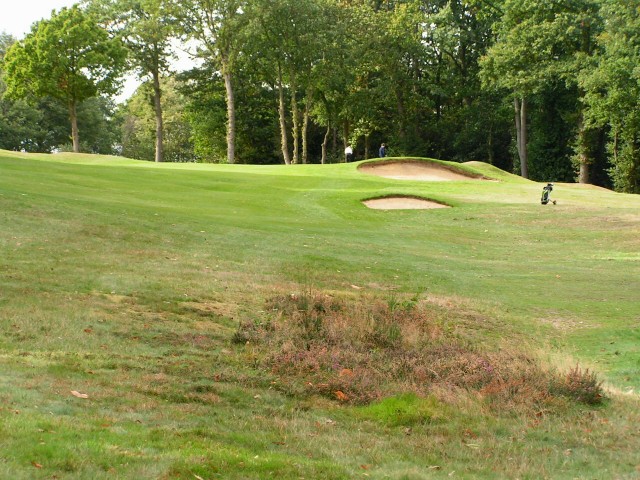
The golfers hole out on the third green. Abercromby moved just enough dirt in creating the green complex to give the hole its fine golfing qualities. Nothing contains a tee ball that bleeds right.
4th hole, 445 yards; Ralph Livingston’s Feature Interview on this site specifically deals with equipment in and around the mid-1920s. In 1912 when The Addington opened, it measured over 6,200 yards, which is within 100 yards of its distance today. This speaks as to the degree of difficulty of the course: in the days of hickory shafts and before the balls got ‘hot’ in the mid-1920s, wood shots were likely required to reach the 3rd through the 5th greens in regulation. To ask the same today of top amateur players requires an architect to build consecutive holes of ~250y-510y-510y, and if he did, golfers would cry foul. Abercromby used the portion of the property with conventional parkland features (i.e. the 1st-5th holes, and the 18th) to build solid, stout holes.
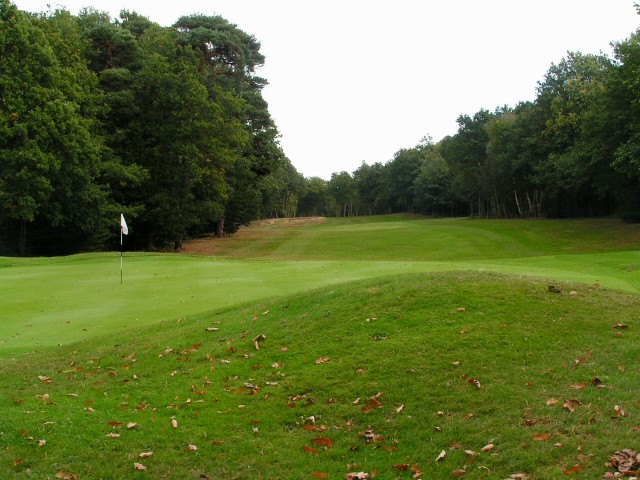
The fourth fairway rolls through the trees before reaching a good size green.
5th hole, 440 yards; Played in the opposite direction as the 4th but across the same side slope, the golfer’s ball is now above his feet for his approach shot.The author would dearly love to know when the bunker was built thirty yards short of the green- when the course opened or closer to Abercromby’s death in 1934 after years of refining his masterpiece? Too many people get caught up in the look of bunkers but placement is far more important and this one is as perfectly positioned as any bunker one can name. Even to this day, the bunker dominates play as many golfers try to have their long approach shots carry just over it and run onto the green. The important thing, of course,is that Abercromby did build the bunker but if it was built early on, it solidifies in many people’s opinion that Abercromby understood design like few others.
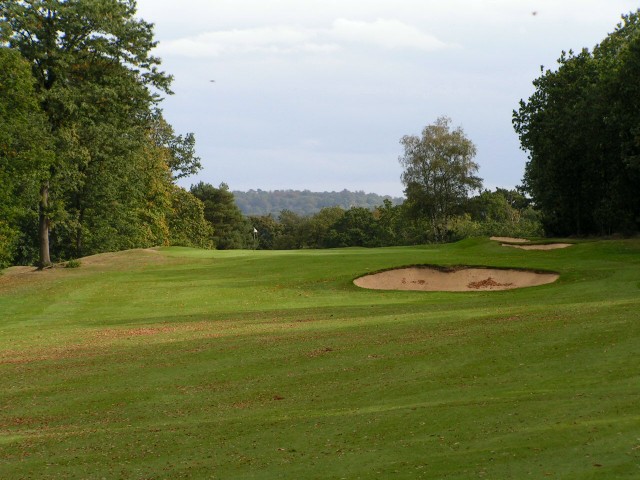
An approach that carries past the large bunker short of the fifth green takes the slope of the ground and feeds left onto the green.
6th hole, 380 yards; The first fives holes are parkland in character and though an excellent example of sidehill architecture as they traverse up the hill,there is no single feature that can’t be found on other parkland courses around the world. And standing on the 6th tee, the first time golfer assumes the 6th follows in the same vein. The view from the tee is to a wide fairway that gently bends to the left. Only when the golfer gets within 70 yards of the green does he appreciate the crater bunker well below the fairway/green level and the first of five bridges that helps the golfer traverse what now becomes rugged landscape.
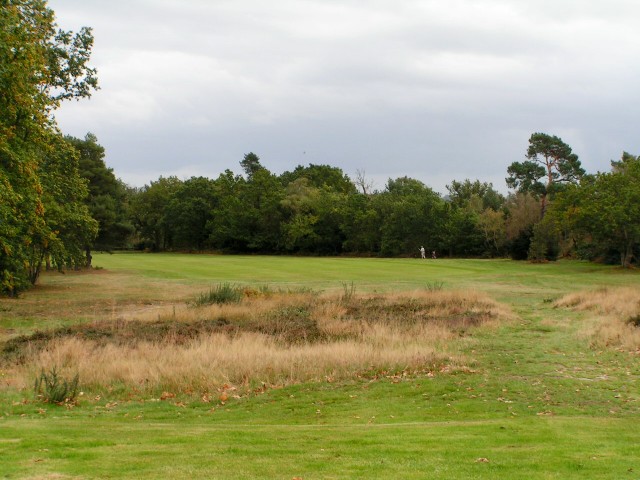
The sixth appears to be a conventional parkland two shotter from the tee with the golfer in hopes of skirting past the trees on the left for the shortest approach shot in on this dogleg left.
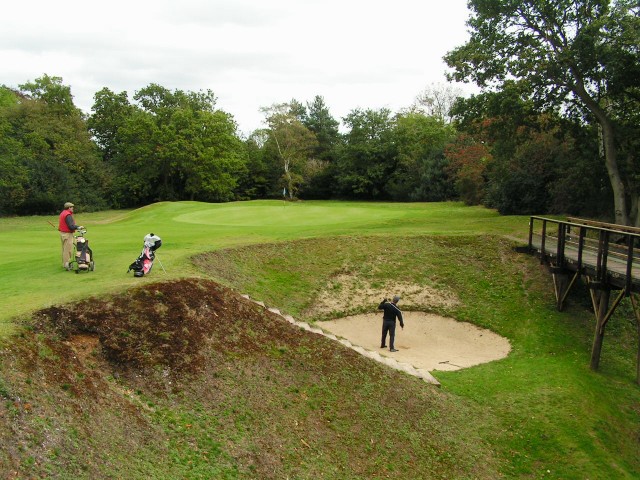
The Addington’s uniqueness in the world of golf begins in earnest as one approaches the sixth green.
7th hole, 150 yards; The third one shotter in the first seven holes is the shortest one so far and is the first forced carry on the course. No ground game options are practical given the terrain but, at this distance, the golfer doesn’t mind. By minimizing the amount of lengthy forced carries, Abercromby ensured that the members with their hickory shafts and Haskell balls could have fun getting around the severe property – a masterful job of routing to be sure.
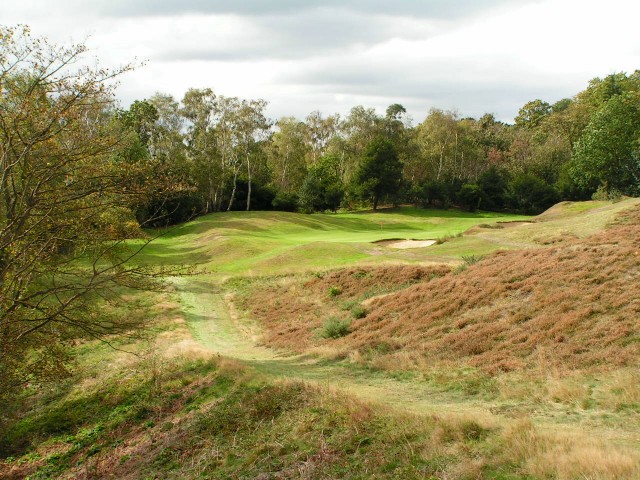
The appealing one shot seventh is set across the right to left sloping terrain.

A closer view of the seventh green complex highlights the slight dell in which the green is sunk.
8th hole, 425 yards; A card wrecker of a hole, this two shotter starts with a blind drive that would beat home on a wild tumbling links course. The crest of the hill is the highest point on the property and the fairway is set along a spine that falls sharply away to the left and right into ravines. As the ravines are obscured by tree growth, the immediate terror of this hole may not become evident until one mishits a shot.
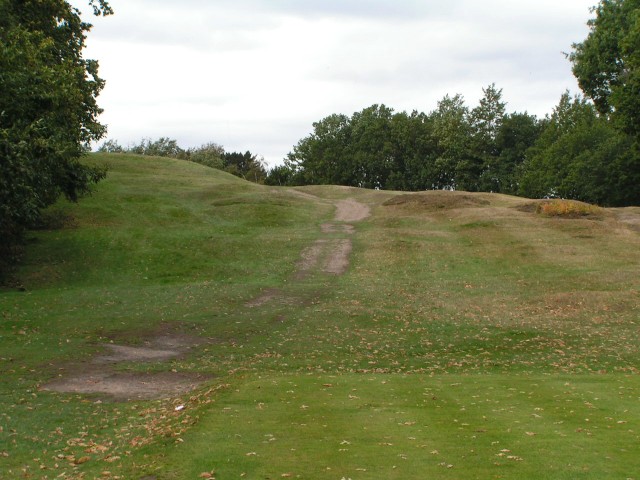
The uphill drive at the eighth offers little guidance or encouragement.
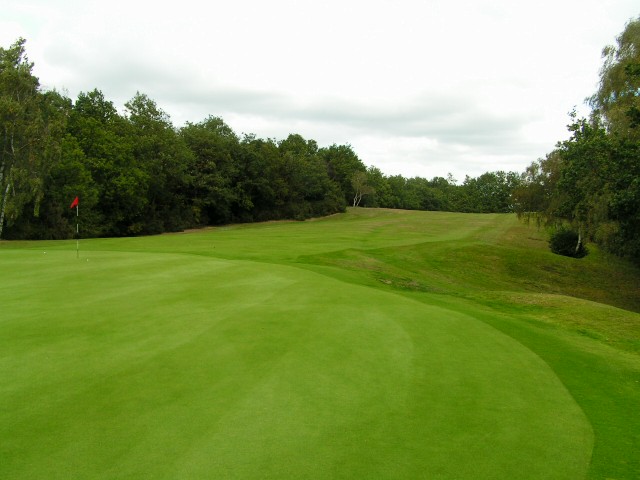
Looking back up the hog’s back eighth fairway, one may be reminded of the playing characteristics of the famous fourth fairway at Rye Golf Club which also falls away on both sides.
9th hole, 380 yards; Two ravines must be crossed to reach the 9th green. In as much as the 9th fairway is thus an island, when coupled with the scale of the forthcoming holes and the general rugged characteristics of the property, general comparisons are often made between a round at The Addington and one at the famed Pine Valley Golf Club in New Jersey. And similarly to that New Jersey design, The Addington is more strategic than penal in nature. The course offers plenty of width and in this case, the closer one drives it near the worse trouble (the ravines on the left and ahead), the easier and shorter the approach. The golfer’s willingness to flirt with such interesting hazards in order to gain a strategic advantage gives The Addington much of its enduring appeal.
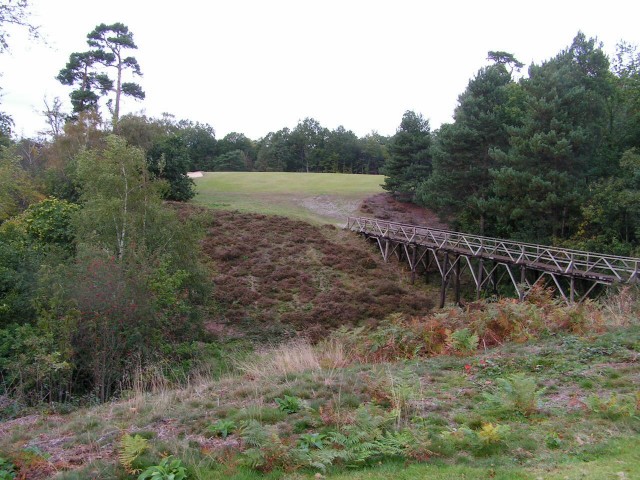
The ninth tee ball is not for the faint of heart though the fairway is wider than it appears. The fairway bunker on the left is one of only three on the course and in this case, is actually a mercy bunker that keeps balls from disappearing left and out of sight.
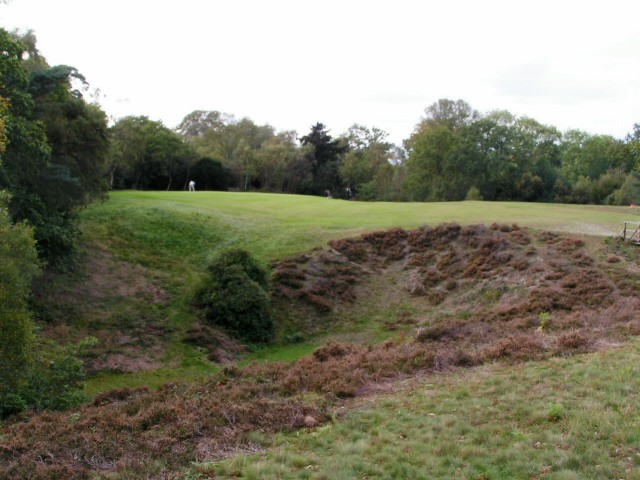
The golfer in white is seen putting out on the bunkerless green which is – cleverly – not well defined and joins the twelfth and fifteenth greens as the most heavily contoured on the course.
10th hole, 390 yards; Though the golfer is now in the heart of visually spectacular golfing country, how good is the architecture? How diverse are the holes? How varied are their challenges? In short, do their golfing qualities remain high? To answer, as the green is always the ultimate target, take a look at 40 yards and in of the 9th, 10th and 11th green complexes. The 9th is bunkerless, hugs the ground and is heavily contoured. The 10th green is pushed up, has three bunkers near it but even the left front one fools the golfer as it is a good ten paces from the front edge of the green, making depth perception tricky. Then at the 11th, the tiny, relatively flat green is well defended with bunkers flush against it. To the author at least, these ever shifting challenges are every bit the equal of the spectacular golfing landscape.

One of the most attractive shots on a course full of attractive shots is the tee ball at the tenth.
11th green, 135 yards; The shortest of the six one shotters is appropriately enough to the smallest green on the course. Plenty of 2s and 4s are had here. Near the high point on the property, the wind is a factor.
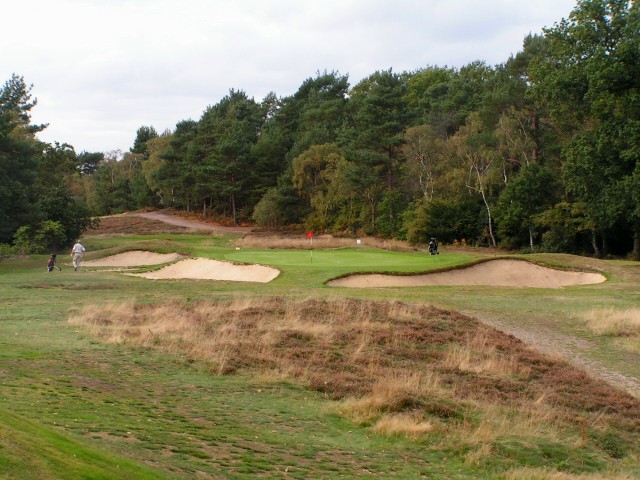
The tiny eleventh green is well bunkered.
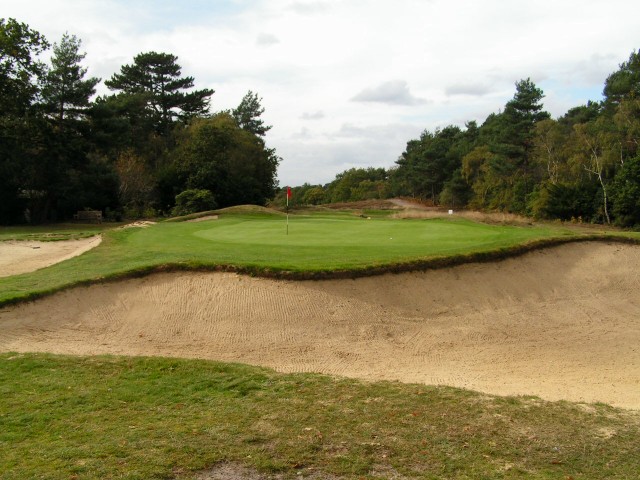
Any tee ball that finds the putting surface leaves a relatively short putt at the eleventh. Conversely, not as many tee balls find the putting surface as one might hope!
12th hole, 485 yards; Completely outrageous, the 12th captures the most exhilarating attributes of old fashioned links golf where it is man vs. nature and there is no set way to play the hole. The tee ball is blind to a fairway that falls sharply away and where the tee ball ends up is a matter of chance. Some days, it may come to rest on a man-made plateau that gives the golfer a level lie for his long approach into the green. More than likely, it won’t and the golfer is left with either a hanging lie or his ball is in a clump of heather or by some miracle, it receives all the right bounces and has chased well over 300 yards from the tee past the natural obstacles to end up in the fairway near the base of the hill. Probably the hole that The Addington is most famous for,it is also the one that could use the most help today: old photos show that the golfer once had the ability to bounce his approach in from the high left area near the green and today that area is covered with tree growth. The option to come in from the left should be restored and hopefully the excellent selective tree clearing program that the Club has undertaken during the past several years will make a mark on this hole as well.
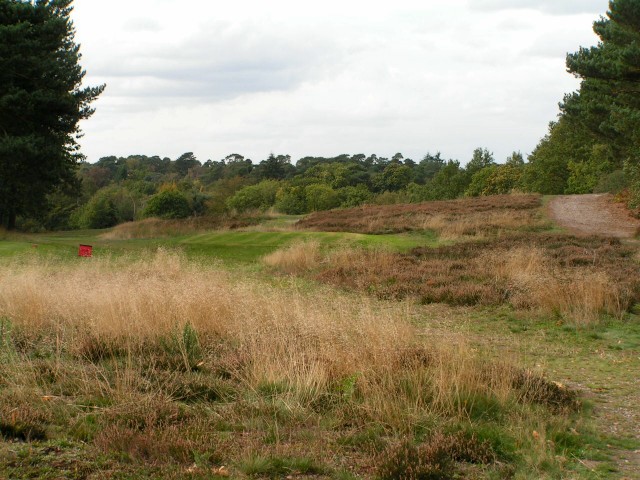
As is frequently the case with many of the finest holes at The Old Course at St. Andrews, the golfer has no clear idea as to the best line off the twelfth tee.
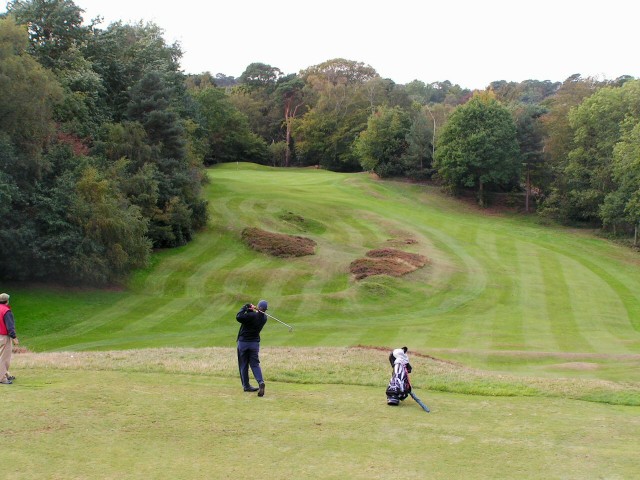
This golfer hit the perfect drive and found the twenty yard deep man-made plateau with his tee ball, giving him the only level lie on the hole. He is left with 220 yards to the most contoured green on the course. The tree growth left of the green needs to be cut back.
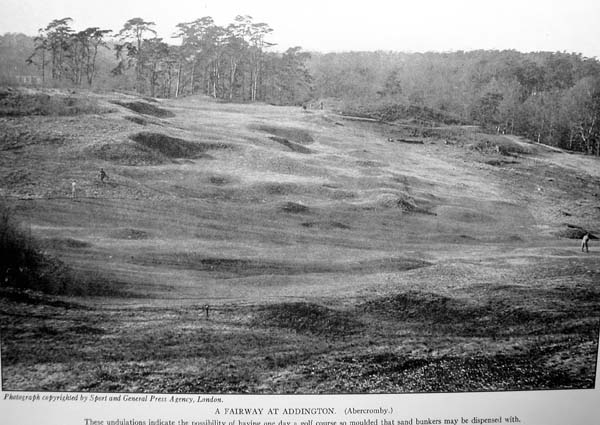
As seen in the mid 1920s, the ball could be bounced in from high left of the twelfth green.
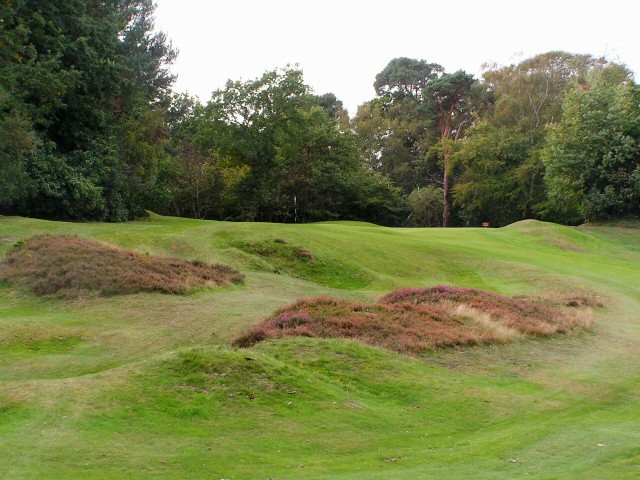
For those golfer’s less fortunate off the tee, the twelfth frequently is played as a three shotter with an uphill pitch required from around here. Given that the twelfth plays across the most turbulent property, Abercromby saw no need to build any bunkers.
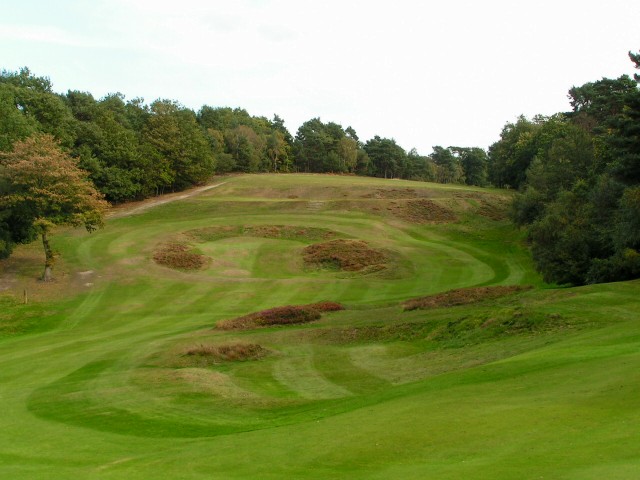
The view from the twelfth green back up the heather laden, humpy bumpy fairway, complete with a man-made plateau tells the story: there is no telling where the tee ball will end up.
13th hole, 230 yards; Peter Dobereiner wrote of the joy of being alive and thatsuch a sensation was all the more intense for him at a place like Royal County Down.All golfers appreciate Dobereiner’s sentiments and for them, that special spot may be the 5th tee at Royal Portrush, or the 8th green at Cypress Point, or the crest of the hill at the 17th at Royal Melbourne West, or the 4th at Banff Springs, etc.). For many, just such a spot is the 13th tee at The Addington.

The sight of a well struck tee ball across the wilderness stays with the golfer forever. The grandness of the setting is rarely found – or matched – in inland golf.
14th hole, 360 yards; The perfect compliment to the heroic 12th and 13th holes, the 14th at first glance appears to be a breather but is as strategically appealing as any hole on the course. The green runs away from the golfer and the only way to get near the right hole locations is from the left side of the fairway, which is the side where all the trouble is.
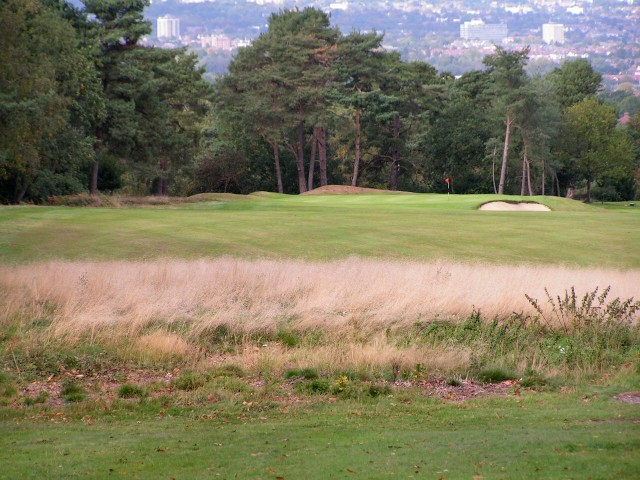
The view from the fourteenth tee shows the wood covered ravine on the left, the green open in front from the left, the right greenside bunker, and The City of London in the background.
15th hole, 440 yards; The Addington is lay of the land architecture with Abercromby only after the best set of collective holes that the property would yield. The fact that the best set includes six one shotters and (originally) two back to back three shotters here and at the 16th shows that Abercromby wasn’t bound by any preconceived notions of a set par or formula of holes. The original design intent of the 15th was to position one’s second shot over a bunker cut into a hill 400 yards off the tee. Once on the higher ground as guarded by this bunker, the golfer looked down the length of a two tier green with a false front. However, as played as a two shotter today, the golfer often comes at this green from an oblique angle, made all the worse the more right(i.e. away from the trouble) that he plays the hole. Numerous 5s are obviously carded here, though the7s and 8s are generally reserved more for the 8th and 12th holes.
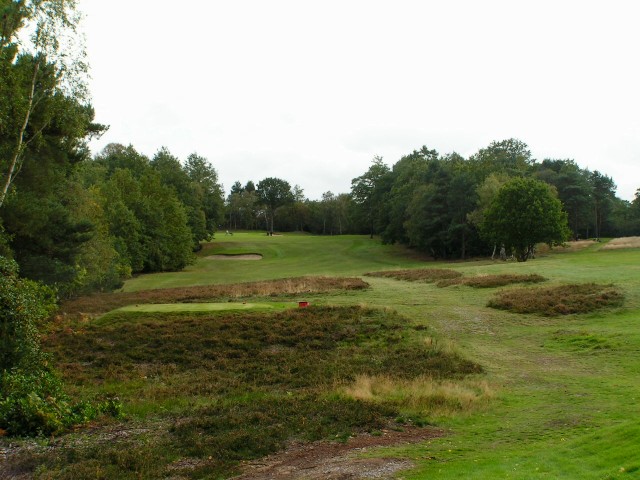
The daunting view of the fifteenth as it plays uphill to a two tier green with a false front. The green is angled to receive shots from over the bunker in the distance.
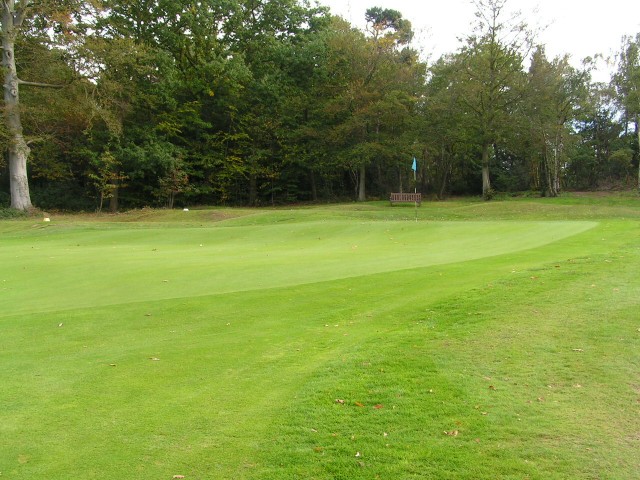
This photograph captures the awkward angle of an approach shot taken from the right center of the fairway. The back hole location is particularly tough to get to and plenty of balls hit on the front edge only to roll off the false front.
16th hole, 510 yards; Overshadowed by the world renowned 12th and 13th holes, this is the favourite hole of many. In viewing the photographs below, one is appreciative of both the possibilities that can only come from wild topography as well as Abercromby’s in the field vision to find/route such a hole. If not for another great half par hole (the 16th at Cypress Point), the author would select this hole for his own Pat Ward-Thomas world eclectic 16th hole. A superb match play hole and it falls at the perfect time in the round.
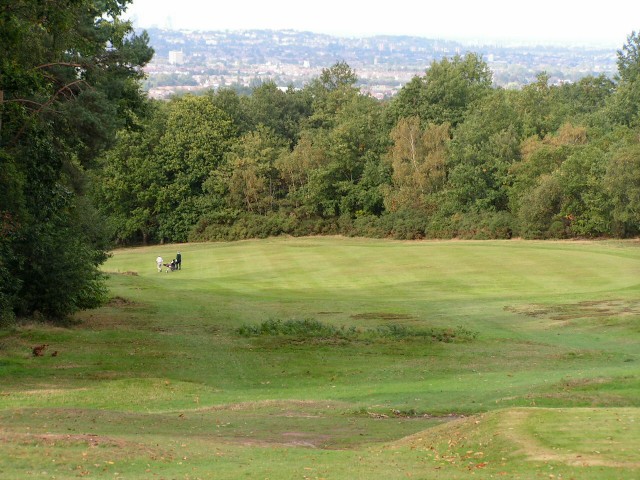
The great right to left sweep of the sixteenth fairway. The ideal drive is a hard draw that lands near the golfers pictured above, tales the slope and scampers downhill for another 50-60 yards.

Golfers that hit to the right side of the fairway off the tee are left with an awkward stance with the ball well above their feet. This becomes problematic as great control is required for the second shot.
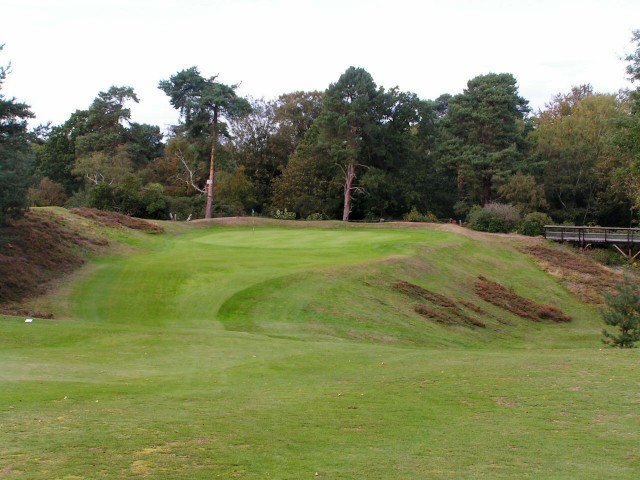
If treated as a three shot hole, the ideal pitch is from the crest of this hill 90 yards from the green. If the golfer has gone for the green in two, one can appreciate the risk-reward in so doing with the heather clad bank left of the green and a thirty foot drop-off to the right.
17th hole, 190 yards; More menacing in appearance than it plays, the 17th plays at a 90 degree angle across the 16th green and gully to a green on the far side. Abercromby gives the impression that the golfer is storming a fortress as he cut the most threatening bunker on the course into the unkempt far hillside.
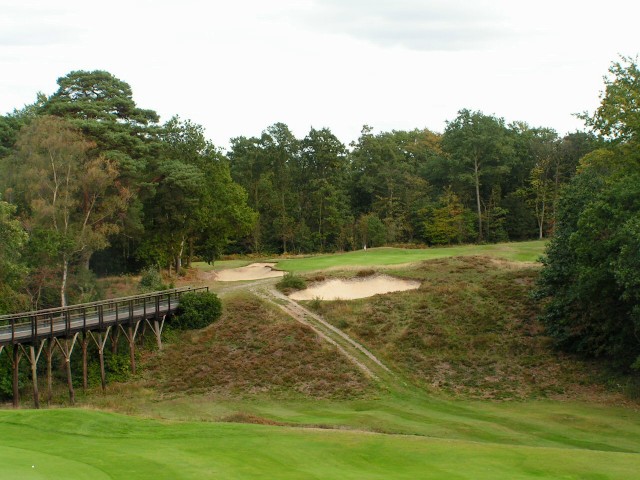
Though hard to believe based on this view of the seventeenth, it is actually one of the less exacting one shotters on the course.
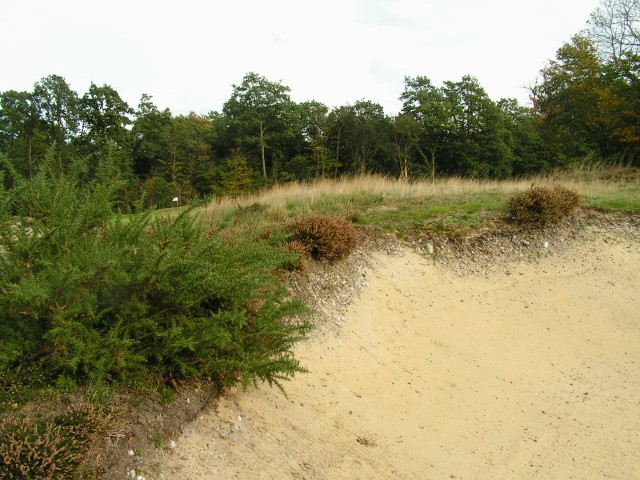
A close-up of this fronting bunker at the seventeenth shows the gravelly nature of the soil with which Abercromby had to work.
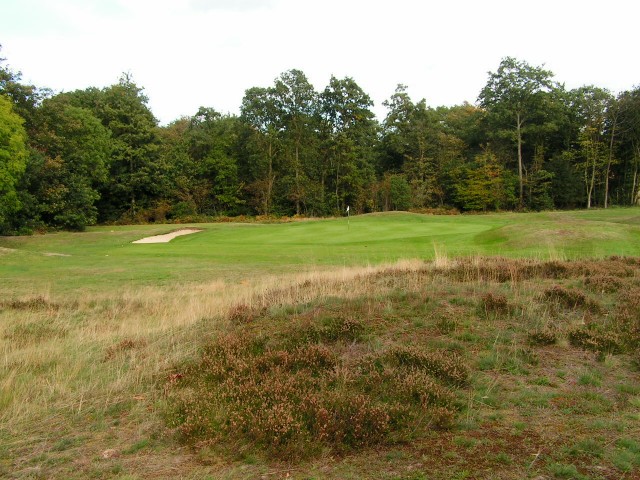
Taken from a top the bunker, the golfer now appreciates that there is indeed plenty of room to bounce a ball onto the green.
18th hole, 430 yards; What is the one type hole that the course has yet to face? A relatively flat one which is exactly how the course now concludes. Though the tee ball does climb a slight incline, the golfer is all but guaranteed to find a level lie in the fairway, one of the few on the course. Five bunkers make it the most heavily bunkered hole on the course, which makes sense given it is on virtually the only featureless piece of property on the course. Abercromby was free to give the hole its character and the fairway bunker at 260 yards off the tee is the most dominate man-made hazard to avoid off the tee on the course.
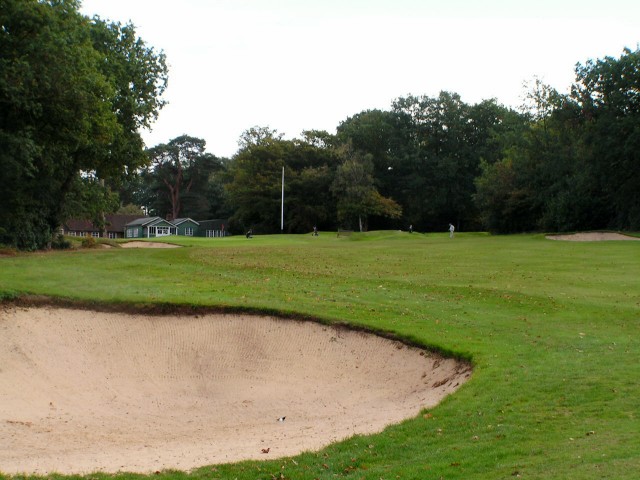
As the unhappy golfer can attest whose ball tee ball ended up here, bunkers provide the playing interest at the eighteenth.
After the round, one repairs to the cozy clubhouse and of all the likely conversations, the author can not imagine any that start with, ‘The Addington reminds me of X course’ save for any general comments re: Pine Valley. Starting with the crater green side bunker at the 6th through the 17th, the golfer experiences to many one-of-a-kind holes and hazards. For a course that measures less than 6,350 yards, the amount of big hitting that is required is surprising. Yet, it is not a slugger’s course either given the tremendous variety of holes and shots that one has just been asked to play. From the tiny 11th to the monstrously long 13th, from the three shot 2nd to the half par 16th, from the stout two shotters that are parkland in nature (the 4th, 5th, and 18th) to the wild two shotters like the 8th, 9th and 12th that resist any form of classification, the diversity is astonishing. One of the reasons that England is the author’s favorite country in the world to play golf is because it seems to have a virtual monopoly on sub-6,400 yard courses that are world class (St. Enodoc, Swinley Forest, Pulborough, etc.). The golfer is asked to hit every shot around The Addington, faces numerous exciting and one-off hazards, and is finished his round on this less crowded course in less than three hours. In every respect, this is an ideal golf course, one of the finest spots for a game in the world.
The End



![Minchinhampton (Old) [2016]](https://golfclubatlas.com/wp-content/uploads/2018/09/Minchinhampton-500x383.jpg)
![St. Enodoc (Church) [2017]](https://golfclubatlas.com/wp-content/uploads/2017/11/St.-Enodoc-500x383.jpg)
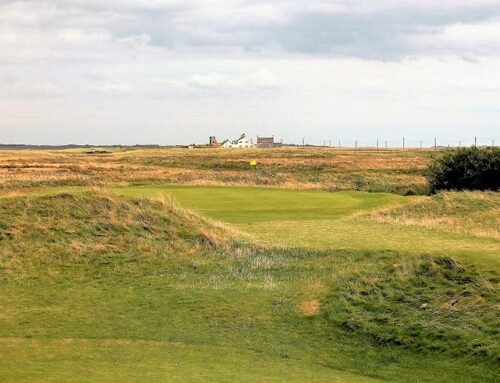
![Sunningdale (Old) [2014]](https://golfclubatlas.com/wp-content/uploads/2017/11/Sunningdale-Old-Course-500x383.jpg)
